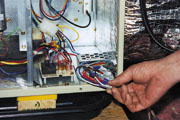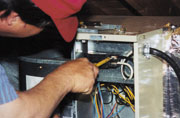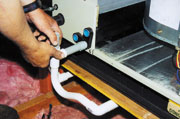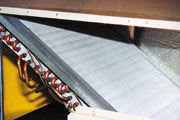

Scott Meenen, owner of G&S Mechanical Services in Laurel, MD, contends that “changing the filter is important, but it’s not maintenance.” In his opinion, changing the filter is an absolute minimum of activity that keeps the unit alive.
Still, not enough homeowners seem to realize the importance of this bare necessity. Even worse, Meenen says, too many new systems are installed with cheap filters; “They need a new filter box” to accommodate better-quality filters. “I’ve seen really good systems ruined” due to lack of proper filtration, he says.

Accessibility
But in order to be able to maintain a system at all, you need to be able to get to it. “Stuff that drives us nuts is when the unit is installed too close to the house, in the mud, or it’s too tight in tubing,” he says. “The easier it is to maintain, the fewer problems you have.”Meenen frequently sees indoor cooling coils installed backwards, in a closet or against a wall. “Then it ices up all summer,” he says.
Heat pump icing in summer tends to confound system owners who don’t understand the unit’s operation. The icing phenomenon, says Meenen, is caused by a low refrigerant charge, a dirty filter, “or the
Heat pump icing in summer tends to confound system owners who don’t understand the unit’s operation. The icing phenomenon, says Meenen, is caused by a low refrigerant charge, a dirty filter, “or the owner tries to run the unit when it’s too cold outside. Head pressure drops, and refrigerant isn’t fed properly to the indoor coil.” As a result, ice forms.
Outside icing is usually a problem with the defrost circuit, Meenen adds. “It’s a control problem, but the compressor is still pumping.” Nonetheless, many servicers replace the compressor. “Too many techs just replace parts,” Meenen says. “They don’t think the problems through.”
In regular maintenance, this contractor pays particular attention to fan motors, inside and out (“some need oiling regularly”). He checks belts for wear and play, and checks the condition of the bearings. “If the oil dries out, bearing damage can occur,” he says.
And this leads us to refrigerant floodback and the role of the crankcase heater, which Meenen describes as an electric heater or circuit that provides heat during the off cycle, keeping the refrigerant and oil from mixing. “Liquid refrigerant will find the coldest place in the system,” explains Meenen.

The Oft-Forgotten Crankcase Heater
Jeff Smith, CMS, president, and ceo of J.A. Smith Heating and Air Conditioning, Inc., Warminster, PA, says that checking the operation of the crankcase heater is “a critical but often overlooked part of normal maintenance.”Crankcase heater devices are located at the bottom of the compressor. They are installed so that oil pooling there during nonoperational times stays warm and thus will not attract liquid refrigerant, Smith says.
When a compressor is not running (such as during mild weather), it’s possible for refrigerant to migrate to the bottom of the compressor, he explains. On start-up there is a reduction of pressure; the refrigerant comes out of solution very rapidly and foams up to the top, carrying oil out of the unit with it. These are sometimes referred to as flooded starts.
According to the Air Cold Supply website (http://www.air cold.com/trouble/compfail.htm), flooded starts are indicated by:
“This is the result of refrigerant vapor migrating to the crankcase oil during the off cycle,” according to a website bulletin. “When the compressor starts, the diluted oil cannot properly lubricate the crankshaft load bearing surface causing an erratic wear or seizure pattern.”
Corrections include locating the compressor in a warm ambient area or installing continuous pumpdown; and checking crank-case heater operation.
The compressor motor may only run for a few minutes without oil, Smith says, but over time this damages the bearings and the compressor dies an early death.
A heat pump or air conditioner will keep working even though the crankcase heater is not. The bearings eventually go bad, “but it wouldn’t be noticed until they are rattling and it’s too late,” explains Smith.

Crankcase Heater Inspection Methods
Older units had continuously operating crankcase heaters, whose operation could be checked by simply touching the metallic band around the bottom of the compressor, Smith says; if it was hot, the heater was working. (Techs got a lot of burned fingers using that method.)Newer units are wired in a relay that shuts them when the compressor operating temperature reaches a certain point. These PTC (positive temperature coefficient) semi-conductor-type crankcase heaters turn themselves off and are therefore more efficient.
However, because they are out of sight and out of mind, buried in the compressor well, they tend to be overlooked during routine maintenance, Smith points out. Air conditioners have them as well as heat pumps. However, they are more critical in heat pumps because these units start up and shut down more frequently throughout the year, whereas a/c unit operation is seasonal.
Smith advises checking the crankcase heater’s operation twice yearly, with normal spring and fall maintenance.
“Inspecting PTC heaters is more complicated because of its location in the little well built into the bottom of the compressor,” says Smith. However, it’s no less necessary to do.
1. Shut the power to the outdoor unit.
2. Tug out the crankcase heater; if it comes out in one piece, let it sit out and cool down. (If it comes apart, it was time to replace it anyway, Smith comments.)
3. Put power to the heater; it should warm up. If it doesn’t, replace it. Or, unwire the circuit that the heater is on and check it out with an ohmmeter. Make sure the wire does not get brittle, Smith advises.

Other Maintenance Tips
Like many service contractors, Tanner Home and Energy, Chambersburg, PA, offers a multipoint service and maintenance package that covers most key aspects of heat pump service.Dean Martin, the company’s service manager, described the company’s 15-point heat pump inspection. “These are not listed in the order that we do them and several are done at the same time,” he explains. “An organized service tech can do this in about an hour.”
1. Check the fan switch to see if the auto and on positions both work properly.
2. Check for visual signs of refrigerant leaks.
“While doing the cleaning, we are constantly looking for anything out of the ordinary, one thing being the presence of oil around any fittings or refrigerant lines that would indicate the presence of a refrigerant leak.”
3. Check voltage and amp draw.
“We use an amprobe to check the voltage and amperage of the outdoor unit during start-up and after several minutes of operation. This gives us an indication of compressor health or system charge.”
4. Check blower operation.
“This is just a simple test while cleaning the indoor unit,” Martin explains. “We will typically jumper the fan control circuit to pull in the fan relay and listen to the fan starting. Slow startup or low airflow draw can indicate a weak capacitor, dirty centrifugal blades, or the beginning of a fan motor winding problem. An imbalanced fan cage is easily detected at this time also.”
5. Check and tighten all electrical connections.
6. Check heat transfer.
“When checking delta T in the heating cycle, be careful to not have any supplemental heat operating as this will surely skew the test.”
7. Check lockout circuits.
8. Check temperature difference across the indoor coil.
“We look for a 18° to 20° difference at the indoor unit. This is a continuation of the refrigerant system check. Again, it is important to make sure that no supplemental heat is being used.”
9. Check the starting contactor.
“This is simply a visual check of the contactor points and coil,” says Martin. “Slight pitting is noted on the workorder.” If the tech finds severely pitted contacts or an overheated coil, s/he recommends that the homeowner replace them.
10. Check the outside disconnect.
“This another visual inspection along with a quick turn of the screwdriver to test for loose connections.”
11. Replace or wash filters.
“If the system has washable filters, we wash them while cleaning the outdoor coil,” says Martin. “If they’re throwaway filters, we replace them for the homeowner.”
12. Check and adjust all safety controls.
“While cleaning the indoor unit, we jumper a test lead to the supplemental heat circuit while pulling a fan lead to test the overheat klixons,” says Martin. “We also check the safety circuits in the outdoor compressor section.”
13. Check and flush the condensate drains.
14. Test the compressor windings.
“We have a megohmeter to test compressor leads to ground. This gives another picture of compressor health or high moisture level in the refrigerant.”
15. Clean the indoor and outdoor coils.
“We use coil cleaner on every job, inside and out, whether it looks like the coil is dirty or not,” says Martin. “We have found coils that look fairly clean on both surfaces but upon application of the cleaner, we find dirt foaming up deep within the coil.
“That’s about it,” Martin sums up. “We also used to list oiling fan motors, but manufacturers recommend oiling only every three to five years, and lately motors have sealed bearings.”
Did we miss anything?

What is agreed upon, however, is that consumers need to be aware of their systems’ requirement for regular care by a trained professional.
Send your recommended service and maintenance procedures to Barb Checket-Hanks at checket-hanksb@bnp.com (e-mail).

Report Abusive Comment